|
Home
About Giant
Alaskan Malamutes
Our Giant Malamutes
The Adults
Giant Alaskan Malamute
Puppies Available
Giant Alaskan Malamute
Past Puppies
Policies/Pricing
FAQ
Alaskan Malamute
Links
Contact MalAMail
Malamute Postcards
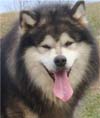
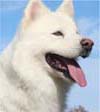
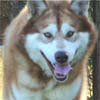
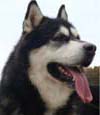
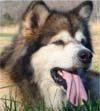 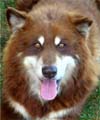
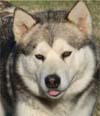
|
Hudson's Malamutes - About Alaskan Malamutes
Mighty and Majestic - "The King of Working Dogs"
Adapted from AlaskanMalamutes.us
Please give credit if you copy this information onto your site
This page represents hundreds of research hours
Do not take these pictures, do not link to these pictures - that is bandwidth theft
Flattering to see the page whole on other websites, but please give credit where credit due
|
The Alaskan Malamute, one of the oldest Arctic sled dogs, was named after the native Inuit tribe called Mahlemuts, who settled along the shores of Kotzebue Sound in the upper western part of Alaska, within the Arctic Circle. Bone and ivory carvings dated to 20,000 years ago show ancient Malamutes almost identical to today's breed.
Malamutes babysat the Mahlemut children while parents were out on hunts which is one reason they make very good family pets.
Their use of dogs was a partnership for survival. In summer, the Mahlemut people fished and hunted inland. In winter, they hunted sea mammals on the coast. Dogs assisted in hauling their possessions between spots, tracking polar bears and other quarry, hunting seals, moving meat from the hunt back to their base and with the hunt itself, as well as lookouts for bears and guarding caribou herds..
Often, they neutered all male dogs except the lead dogs. This ensured that females were bred only by the best dogs. Traits were maintained by the most basic criteria - survival. The dogs that prevailed were most suited for the environment, and for the work. When the first outside explorers came to the region in the 1700s, they were impressed not only by the hardy dog but also by their owners’ obvious attachment to them.
Early writings indicate that the dogs kept by the Mahlemut people were better cared for than was usual for Arctic sled dogs, and this seemingly accounts for the breed’s affectionate disposition.
|
View the AKC
Alaskan Malemute Video
MPG format
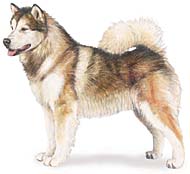
Visit AKC Alaskan Malamute page
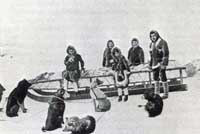
|
Such was the prowess of the malamute that Eskimos who lived inland traveled down the Kobuk and Noatak rivers to Kotzebue Sound to trade furs for dogs and supplies. Thus did malamutes find their way to other regions of Alaska and even to adjacent parts of the Yukon, where the gold diggers and some of the dogs that had accompanied them to the Yukon made the malamutes' acquaintance some 100 years ago. (Additional testimony to the malamutes' hegemony was the use of the word Malamute to indicate any freight-pulling dog).
("If Looks Could Thrill")
The Alaskan Malamute is the native Alaskan Arctic breed, cousin to the Samoyed of Russia, Siberian Husky (Kolyma River Region), and the Eskimo dogs of Canada, Greenland and Labrador. As a group these dogs are referred to as "Northern", "Nordic", "Spitz-type" or "Arctic" (all refer to a dog characterized by a natural, fox- or wolf-like head with erect ears; double coat with harsh, weather-proof outer coat and a dense, woolly undercoat; well-knuckled, thickly padded feet; and a tail which rises over the back to some degree). Also in this group are Japan's Akita and the smaller Shiba Inu, as are the Norwegian Elkhound and Buhund, Finland's Karellan Bear Dog, Holland's Keeshond and many others.
As with the breeds referred to above, the Alaskan Malamute is considered a "primitive" breed, in that it has been around for millennia, and not just centuries (or less), as is the case with many of today's "modern" breeds. This means the original temperament and instinctive behavior patterns remain strong in this breed accustomed to unthinkable hardship and deprivation.
There is a natural range of size in Alaskan Malamutes. Malamutes in weight are "standard" size 65-85, but can weigh up to 140lbs or more, which are considered the Gentle Giants. The "standards" were created originally by one person's modern vision of an ideal malamute (who also never bothered to go to Alaska or the Arctic) and reluctantly increased slightly upward after great political infighting within the AMCA in the 1950s. The functionality for what the dog was originally intended is more important than the size.
The Alaskan Malamute is a member of the Working Group and was first registered by the AKC (American Kennel Club) in 1935.
The Malamute is a true pack animal with the natural instinct to "lead or be led"; therefore, training must begin as early as two to three months of age, so that you lead and not the dog.
Alaskan Malamutes are fun loving dogs, and have a sense of humor. They are also incredibly independent-minded, not surprising, given their intelligence. This also strengthens the need to begin training early. Training based on rewards and encouragement, rather than force will gain optimum results. Because of their independent-mindedness, they will push every boundary as pups. Be prepared to be consistent and firm, this breed will test your will to make sure you are still the "leader" or "alpha". If they find you are not, they will assume the "alpha" role, a situation you do not want.
They tend to learn fast, and get bored easily, so they need owners who are prepared to keep them on their toes and interested in training. They won't carry on performing the same task in the way a more obedient or obsessive breed might, rather they will simply stop cooperating, or decide to do something else more amusing, if they are asked to do the same obedience exercise too often. They are often described as bright, but stubborn. Clumsy efforts to 'show them you are the alpha' tend to be met with amusement, boredom or hostility. Alaskan Malamutes do benefit from long-term training, however, they just want you to make it interesting. Training should begin while they are pups, and firm house rules should be laid down for pups, since it's easier to teach them rules while they are little. These are generally headstrong dogs, so consistency about rules you want them to follow as adults is important right from the start as stated above.
Persons who are steady enough to cope with a growing malamute will be rewarded with a lifelong companion whose devotion is boundless; but, they caution, it takes commitment and determination to get through to the often-stubborn malamute puppy, whose ancestors were created to push on through ice, sleet, snow and impossible storms. Such tasks required an inbred determination - that isn't something the malamute switches on and off at its owner's whim. You can guide a malamute in the direction you want it to go, but you can't push it there. Nor can you be heavy handed. A malamute will not tolerate abuse. If subjected to abusive treatment on a continuing basis, the most amiable youngster can become a neurotic and unpredictable adult.
The experienced malamute owner knows how quickly the average malamute understands what you are trying to teach it -- and how long it can be before the fully understanding malamute chooses to comply. When what we are asking of them, makes no "doggie logic" to them, they will take their time to comply - giving you the chance to stop being ridiculous in their minds. When they realize you aren't giving in, but are consistently asking the same thing, they will give in (be prepared to be tested months in the future on the same issue - as they need to be sure you haven't changed your mind on this "non-doggie logic" request).
Malamutes tend to be gregarious, but with humans more so than with other dogs.
In general, Malamutes have never met a stranger, but greet strangers as long lost friends. Because of this friendly nature, as a rule, they do not make good guard dogs. However, their sheer size and appearance is intimidating to strangers.
Because the Alaskan Malamute was developed in the Alaskan wilderness, and all members of the human group were part of the dominant pack, and all of their belongings were shared between them and unexpected strangers were welcomed with hospitality - there was no need for the Mals in the community, to guard the humans' belongings against human intruders.
Malamutes are often quiet dogs that rarely bark, but often utter a range of yips, snorts, growls, rumbles, howls, and woo-woos. Some will harmonize soulfully in concert with every siren, and others seldom or never howl. A minority of Mals do bark, there is no 100% rule.
Mals are generally clean and don't "smell like dogs". They tend to groom themselves feline fashion, removing dirt or mud from themselves. They "blow" their undercoats in spring and again in fall and will need daily brushing during this major shedding time so that you keep the furry "tumbleweeds" to a minimum. During the rest of the year, a weekly brushing will keep the furry tumbleweeds away.
Malamutes need something to do or they tend to develop behavioral problems, like wrecking the house, and digging up the garden. Digging seems to be inbuilt, both digging holes for fun, and to lie in. You can allow them to use the spot they have selected, and just give up putting plants there, or encourage them to use a particular spot, by burying treats in their own sandpit.
They can obviously be trained as sled dogs, and for weight-pull. Mals like to accompany their owners on long walks. Alaskan Malamutes can have especially strong prey drives, and can take after cats. They were bred to be sled dogs, not to do obedience exercises, so are best suited to this, if you can work them. Mals have also shown themselves to be accomplished in Agility, Search & Rescue, and as Therapy Dogs. Remember to keep their training interesting, not repetitious or boredom will take over.
Alaskan Malamutes are patient with children, but should always be supervised during play (as should any dog with children).
Mals do get along with other dogs, they are social animals, when they are properly socialized with other dogs. All my dogs get along together, because they are socialized - they live, play, eat and sleep together.
Malamutes can be a threat to livestock. "The ancestors of today's Malamute were sometimes forced to hunt, forage, and compete for food," warns one malamute rescue group. "Consequently, malamutes have a predatory streak, and, if allowed to run loose in rural areas, will reliably slaughter livestock and wild animals. In urban and suburban areas a loose malamute is a menace to cats. Swift, fearless, and powerful, malamutes have been known to catch songbirds on the wing and, if challenged, to deal harshly with other dogs ... Anyone unprepared to deal firmly and calmly with this wild streak should not own a malamute."
The hunting style of a Mal is akin to feline style. Quiet, stealthy, stalking. They can catch mice, rabbits, birds and cats - to name a few. If socialized with cats they tend to view them as part of their pack, but this may not translate to cats encountered outside.
Because they were bred to be such Herculean workers, Malamutes need daily exercise on a leash or in an enclosed area. The person who cannot provide that exercise and the firm-but-fair discipline that enables the Malamute to function best in society should look for a less demanding breed of dog.
Coat Color
| Color |
Description |
| |
Body Color |
| Black |
Black guard hair with black or dark gray undercoat |
| Alaskan Seal |
Black or black-tipped guard hairs with white or cream undercoat. Dog appears black at a distance, but is not a true black because of the light undercoat |
| Wolf Sable |
Black or gray guard hairs with a reddish undercoat and red trimmings. Both black and red factors evident. |
| Wolf Gray |
Gray guard hairs with light gray, cream or white undercoat. Dog definitely appears gray even though there may be some black hairs on the topline. No red factor evident. |
| Silver |
Light gray guard hairs with white undercoat |
| Red |
A definite shade of red. Either light or dark, with liver lips and nose and light eye color. No black factor evident. |
| Blue |
An off-black or bluish-charcoal color. Eye color may be affected. No black factor evident. |
| White |
Both guard hairs and undercoat are white. Often evidence of a mask in cream color. Only solid color allowed. |
| |
|
| |
Trimmings |
| |
Shades of gold, cream, buff, brown, or reddish hues often found on legs, ears, tail, and face between white areas of the underbody and the dark color above. |
| |
|
| |
Face Markings |
| Cap |
A cap of color covers the top of the head and the ears, usually coming to a point in the center of the forehead |
| Goggles |
Dark areas under the eyes, extending sideways to the cap |
| Bar |
A dark area extending from the center point of the cap down the nose. |
| Eye Shadow |
Dark markings under the eyes which do not extend out to the cap. |
| Star |
A small white spot in the center of the forehead |
| Blaze |
A white mark extending from the center point of the cap back up the forehead. Width and length can vary. |
| Open Face |
A cap covering the head with no other markings on the face. |
| Closed Face |
Dark coloring covering the face with no distinct markings on the face. |
| Full Mask |
Combination of cap, goggles, and bar. |
| Mask |
Combination of cap and goggles. |
| |
Chest Markings |
| Necklace |
Curving band of dark color across the chest. |
| Eagle |
Two bands of dark color protruding partially across the chest forming a pattern resembling the eagle emblem. |
| |
Neck Markings |
| Collar |
White band of color encircling the neck. |
| Withers Spot |
White mark varying in size but centered at the withers or at the base of the neck. |
*See Past Puppies For Examples of Above
The standard has been changed with each revision to include some marking and color variations. The latest revision (1994) adds red and sable, but still does not address blues.
Blue is not addressed in the current color listing, but it also does occur. Unless they are compared in good lighting, distinguishing a blue dog from a black can be as hard as separating navy blue and black socks. However, a blue can be easily identified by inspecting the nose, lips, eye-rims, and pads. Instead of the normal black, these will be dark bluish-charcoal rather than black. Likewise, a red will have liver pigment in these areas.
Adapted from "The Alaskan Malamute: Yesterday and Today" by Barbara A. Brooks/Sherry E. Wallis
Show judges have not yet caught up to the standard and lean toward the comon colors, grays and seals. Red dogs and all white dogs have had successful show careers, but showing reds and whites can be an uphill struggle until the judges catch up with the standard.
Size
There is a natural range of size in the breed. The desirable "standard" AMCA freighting sizes are:
Males, 25 inches at the shoulders, 85 pounds.
Females, 23 inches at the shoulders, 75 pounds.
However, size consideration should not outweight that of type, proportion, movement, and other functional attributes.
From AKC Standard
M'Loot dogs are larger than Kotzebue dogs, as are Hinman-Irwin dogs (which heavily influenced the Husky-Pak dogs). There are virtues in all three strains, and the results of crossing the strains. Today most Alaskan Malamutes are the result of mixing M'Loot with Kotzebue or Husky-Pak.
However, many foreign clubs, (UK, France and others) have desirable freighting sizes as a range of 25 to 28 inches for males, and 23 to 26 inches for females.
Interestingly, most show malamutes appear to be above the AMCA standard sizes, despite the AMCA's slavish adherence to the standard inches & pounds in print.
"Despite what our standard says, I am not at all convinced that 85-lb males and 75-lb females are "the ideal freighting size". That statement was a compromise, the best we could do then, and a lot better than the way it was. But, I always felt the "original Malamute was a big dog, even after many generations of survival in a harsh environment. I think the old photos show that. In the 1950s, near Lake Placid, NY, I saw real, honest-to-God good-type Malamutes, brought out of the arctic by Jacques Suzanne, that were bigger than any real Malamutes I have seen before or since.
For many reasons I was told that anyone who ever worked sled dogs had found that big dogs "much less efficient" thant the smaller ones. Some even said any dog over 80-lbs was clumsy and more likely to break down and drop out. Not being a driver, I couldn't argue. But now that opinion has been made to look silly by Will Steger and his gallant companions who journeyed totally across Antarctica in what has to be said the greatest feat of human and canine endurance ever on this earth. They accomplished with teams of 100-lb dogs - and their performance was magnificent!"
Robert Zoller
Also interesting is that Arthur Walden, who brought Malamutes and other sled dogs to New England from Alaska and the Yukon, preferred the larger dogs (120 lbs to 165 lbs) for freighting. Mr. Walden actually drove dogs in the 1890s (pre Gold rush and during), for his freighting business. He acquired his dogs from the Innuit, and learned from them. He was able to survive the harsh Arctic and maintain his freighting business because of his dogs, the only reliable transportation there.

Historical Tidbits
Capt. William Edward Parry, Igloolik, 1824
The dogs of the Esquimaux, of which these people possessed above a hundred, have been so often described that there may seem little left to add respecting their external appearance, habits, and use. Our visits to Igloolik having, however, made us acquainted with some not hitherto described, I shall here offer a further account of these invaluable animals. In the form of their bodies, their short pricked ears, thick furry coat, and bushy tail, they so nearly resemble the wolf of these regions that, when a light or brindle colour, they may easily at a little distance be mistaken for that animal. To an eye accustomed to both, however, difference is perceptible in the wolf, always keeping his head down, and the tail between his legs in running whereas the dogs almost always carry their tails handsomely curled over the back.
A difference less distinguishable, when the animals are apart, is the superior size and more muscular make of the wild animal, especially about the breast and legs. The wolf is also, in general, full two inches taller than any Esquimaux dog we have seen; but those met with in 1818, in the latitude of 76 degrees, appear to come nearest to it in that respect. The tallest dog at Igloolik stood two feet one inch from the ground, measured at the withers; the average height was about two inches less than this.
The colour of the dogs varies from a white, through brindled, to black and white, or almost entirely black. Some are also of a reddish or ferruginous colour, and others have a brownish-red tinge on their legs, the rest of their bodies being of a darker colour, and these last were observed to be generally the best dogs. Their hair in the winter is from three to four inches long; but besides this, nature furnishes them during this rigorous season, with a thick undercoating of close soft wool, which they begin to cast in the spring.
While thus provided, they are able to withstand the most inclement weather without suffering from the cold, and at whatever temperature the atmosphere may be they require nothing but a shelter from the wind to make them comfortable, and even this they do not always obtain. They are also wonderfully enabled to endure the cold even on those parts of the body which are not thus protected, for we have seen a young puppy sleeping, with its bare paw laid on an iceanchor, with the thermometer at -30 degrees, which with one of our dogs would have produced immediate and intense pain, if not subsequent mortification.
They never bark, but have a long melancholy howl like that of the wolf, and this they will sometimes perform in concert for a minute or two together. They are besides always snarling and fighting among one another, by which several of them are generally lame. When much caressed and well-fed, they become quite familiar and domestic; but this mode of treatment does not improve their qualities as animals of draught. Being desirous of ascertaining whether these dogs are wolves in a state of domestication, a question which we understood to have been the subject of some speculation, Mr. Skeoch at my request made a skeleton of each, when the number of all the vertebrae was found to be the same in both, and to correspond with the well-known anatomy of the wolf.
Journal of a Second Voyage of Discovery
Capt. William Edward Parry, 1824
Capt. G.F. Lyon, 1824
These useful creatures being indispensable attendants on the Eskimaux, drawing home whatever captures are made, as well as frequently carrying their masters to the chase, I know of no more proper place to introduce them, than as a part of the hunting establishment. Having myself possessed, during our second winter, a team of eleven very fine animals, I was enabled to become better acquainted with their good qualities than could possibly have been the case by the casual visits of Eskimaux to the ships.
The form of the Eskimaux dog is very similar to that of our shepherd's dogs in England, but he is more muscular and broad chested, owing to the constant and severe work to which he is brought up. His ears are pointed, and the aspect of the head is somewhat savage.
A walrus is frequently drawn along by three or four of them, and seals are sometimes carried home in the same manner, though I have, in some instances, seen a dog bring home the greater part of a seal in panniers placed across his back. This mode of conveyance is often used in the summer, and the dogs also carry skins or furniture overland to the sledges, when their masters are going on any expedition.
It might be supposed that in so cold a climate these animals had peculiar periods of gestation, like the wild creatures; but on the contrary, they bear young at every season of the year, and seldom exceed five at a litter. In December, with the thermometer 40 degrees below zero, the females were, in several instances, in heat. Cold has very little effect on these animals, for although the dogs at the huts slept within the snow passages, mine at the ships had no shelter, but lay alongside, with the thermometer at 42 degrees and 44 degrees, and with as little concern as if the weather had been mild.
I found, by several experiments, that three of my dogs could draw me on a sledge, weighing 100 pounds, at the rate of one mile in six minutes; and as a proof of the strength of a wellgrown dog, my leader drew 196 pounds singly, and to the same distance in eight minutes.
At another time seven of my dogs ran a mile in four minutes thirty seconds, drawing a heavy sledge full of men. I stopped to time them; but had I ridden they would have gone equally fast; in fact, I afterwards found that ten dogs took five minutes to go over the same space. Afterwards, in carrying stores to the Fury, one mile distant, nine dogs drew 1,611 pounds in the space of nine minutes! My sledge was on wooden runners, neither shod nor iced; had they been the latter, at least 40 pounds might have been added for every dog.
The Private Journal of Capt. G.F.Lyon, 1824
Arthur Walden, Alaska & Yukon Territory, 1896-1898
"Early this winter, I made up my mind I would become a freighter, or what was called locally a 'dog-puncher'..... While everybody in this section had driven dogs more or less, there were only five of us who made this our entire business...... A dog-team with equipment for heavy freighting is totally different from that used for any other kind of dog driving. It consists of from six to seven large, heavy dogs of the native breed. We always like to have two dogs who could lead if possible, so that when breaking trail one could relieve the other."
"These dogs were locally call 'Malamutes,' from a tribe of Eskimos living at the mouth of the Yukon, from whom we got most of our dogs. The Eskimo dog, the Husky, and the Malamute are all the same breed. Variation in size is accounted for by the food they had had for generations in their particular localities.
There was another breed of dogs called the 'Porcupine River' or 'Mackenzie' Husky. These originated a great many years ago from a cross of the Eskimo with some large domesticated dog and were the best freight dogs I have ever seen, being far superior to the Eskimo and much larger and stronger. One team of these dogs, the finest I have ever seen, weighed from 145 to 165 pounds each, in working flesh."
"......On the way home, one of my large Eskimo dogs, who had been following me, saw the tracks in the snow some distance ahead, but standing lower than I did he hadn't actually seen the wolf. He made a rush ahead until he got the fresh scent of the wolf, when he hustled back to me with his tail between his legs. This shows the fear of the Eskimo dog for the wild wolf."
"....It was here that I made a trip of 110 miles with my dogs without a stop. The latter part of this long trip, as the weather was warm, I slept a good part of the time on my sled. The trip was up the lakes and back again, and as the dogs had been there before and knew where they had to go, they didn't turn off on the innumerable side trails that led to men's camps along the way. They kept up a steady trot the entire distance. The journey goes to show what the Eskimo dog can do."
".....After my first attempt to find the trail myself, I turned everything over to Ribbon, and within 100 yards he picked up the trail again. These gullies kept recurring all day long, and were from 100 feet to half a mile in width, but this dog never made a mistake and always picked up the trail on the other side. When our heavily loaded teams had come over on the way out, they had not crossed directly, but had gone either up or down, so as to find an easy way up the bank. Since that time from 10 to 50 feet of snow had been blown into these gullies, so it was utterly impossible for Ribbon to smell the trail. If you ask me how he did it, I simply don't know, but he struck the trail squarely every single time and never had to find it from the side.
"This leader of mine was the first dog I had bought on the Yukon. He had come up from Norton Sound on the steamboat... so this type of country was really like home to him. He was a large black Malamute, of the old-fashioned type, and I had used him more as a leader than any other one dog. He had never gone back on me in any way.
"I lost him the next summer, when he was taken with madness over on the Inmachuk and I buried him over there with his harness on. There was an old tradition up there that a dog who is buried with his harness on will work for his master in the happy hunting grounds. I think I have a full team waiting for me. But trouble will certainly be brewing, for they were all leaders."
Arthur Walden, 'A Dog Puncher on the Yukon'
Alaskan Gold Rush, 1898-1906
Dog teams were the primary method of hauling freight throughout the region. Teams were hitched to sleds in winter, and to small trams on rails, to cars and even to barges (along streams) in summer. Many "outside" dogs were brought in and bred to the native Alaskan dogs.
Alaska Telegraph Line - 1901
The future "father of the Air Force", Lt. Billy Mitchell was sent to Fort Egbert in Alaska (near Eagle) in 1901 to supervise the building of the Washington-Alaska Military Cable and Telegraph System. Hardly any work was being done. Troops had been using horses to haul equipment during the summer, but all worked ceased for the long winters. With a 5 year completion deadline, Lt. Mitchell innovatively consulted local natives and civilians. He then devised a plan to use dog teams to move equipment and supplies during the winter. He was the first military leader to purchase sled dogs and keep them year round. Following advice of the locals, he became an expert at selecting sled dogs, and acquired 200 dogs, which he kept corralled at Fort Egbert running loose in a huge pack. One of his best dogs was a 120 lb "Mackenzie River husky", Pointer. This dog saved his life after he fell through thin ice. Lead dog Pointer pulled the entire team and Mitchell free.
Lt. Mitchell used techniques acquired from native Alaskans - removing incisors; stand by with whip during feeding time to ensure no dog would steal the others' food or start a fight.
Teams of dogs and men worked to move cables, poles and other equipment. Because of this, the telegraph line was completed in 2 years - 3 years ahead of schedule!
adapted from Soldiers & Sled Dogs by Charles L. Dean
1908 Alaskan Malamute description:
"There are three broad divisions among the dogs of the North. . . The malamutes have gained the widest fame of the three, their name being so closely linked to the interior that one suggests the other. They are hereditary workers, their ancestors for hundreds of years back having toiled along the frozen trails of Alaska and the British Yukon in Indian and Eskimo teams. . . . They are 'wise' in the slang meaning of the word, it being a common saying along the . . . Yukon that a malamute is 'the most cheerful worker and the most obstinate shirk; intelligent or dense, but always cunning, crafty, and wise; stealing anything not tied down.'
These wiry sled-dogs came originally from the lower Yukon country, their name, according to the Indians, being derived from the word Malamoot, the name of an Eskimo tribe living on the Bering Sea coast, the first natives it is believed to develop the sled dog in Alaska. . . .
The typical malamute's thick gray hair, his short stout neck, sharp-pointed muzzle, the erect pointed ears, and heavy forequarters suggest the gray wolf of the Far North, while the self-reliant independence of his bearing as he stands between the traces shows his descent from a long line of toiling sled dogs. With generations of workers behind him, he makes an exceptionally strong and reliable leader, in that place displaying the cunning, wisdom and trickery that characterize his breed. No smoother or smarter leader exists. No other can make life so miserable for an inexperienced or cruel 'musher.' So observant is he that once he passes over a trail its most insignificant details seem engraved on his memory, and years later, no matter how much snow has fallen or how badly the narrow road has become drifted, he will follow it with unhesitating certainty. He will find the way and guide the team to some lonely outpost, even with the 'musher,' . . . lies half-unconscious . . ."
Mr. Jackson B. Corbett, Jr. - a reply to a Gazette article written in 1908 by Commodore Peary about the Greenland Eskimo Dogs he used on his North Pole expedition.
1908 - Siberian Huskies first introduced into Alaska & Yukon Territory
World War I
During this war, the French desperately needed a way to get relief supplies to their troops. Famed dog driver & racer, "Scotty" Allan, already consulted by Arctic explorers Roald Amundsen and Vihjalmur Stefansson and others, was sought out by the French government to supply dogs and sleds and to train soldiers in dog driving. After secretly transporting dogs from Alaska to Quebec by rail, he acquired additional dogs. The problem was to get the dogs across the Atlantic without tipping off German submarines of their cargo. They didn't want the dogs on deck because their noise would alert enemy subs. "Scotty" Allan trained the dogs not to sing or bark during the 2 week passage, and they were housed in shipping crates chained to the deck.
Once in France, Allan trained 50 Chasserus Alpins (French mountain soldiers) to drive the dogs. The men had to overcome the language barrier and learn to give the dogs English commands. Less than 2 months after leaving Nome, dog teams with French drivers were hauling supplies and ammunition to areas that previously could not be reached. One group of these dogs delivered 90 tons of ammunition to an artillery battery in only 4 days, where it had taken up to 2 weeks for a combination of men, horses & mules to accomplish the same thing. On another mission, dogs assisted in laying over 18 miles of field telephone wire in one night, allowing a totally isolated unit to communicate with headquarters again.
When the snows melted, dogs were hitched to narrow gauge railway cars so they could continue to transport supplies and munitions.
Three Alaskan sled dogs in French service were awarded the Croix de Guerre, one of France's highest military honors, for their actions in combat. All of the dogs who worked with the Chasseurs Alpins were rewarded with a life of leisure for their heroic service to their adopted country.
The British Army (international force in northern Russia & Siberia) used Canadian dog teams with Canadiean soldier-drivers. The dogs were "usefully employed in drawing stretchers with wounded from the firing line."
The U.S. Army made no use of sled dogs during this war. They did maintain sled dogs in Alaska during and after this war as it had be proved that in Alaska's winter, dog teams were the only dependable transportation.
adapted from Soldiers & Sled Dogs by Charles L. Dean
The 1925 Serum Run to Nome
The last driver to arrive in Nome was Gunnar Kassen. His lead dog, Balto (owned by Leonhard Seppala), was a sturdy little Malamute. Seppala with his other team, lead by a 12 year old Siberian Husky (Togo) did the bulk of the work, but Balto got the bulk of the fame and a statue in Central Park. Photos of Balto below:
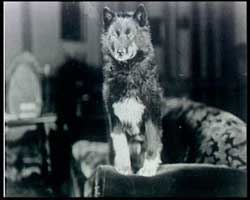
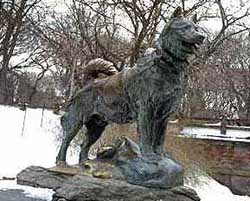
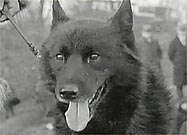
Arthur Treadwell Walden
Walden was a writer ('A Dog Puncher on the Yukon'), an explorer, a dog driver, sled dog racer and breeder. Walden got involved with Malamutes (his best lead dog, Ribbon, was a large black Malamute) while living in Yukon Territory as a respected sledge driver in the dog-freighting business. While freighting, he was the first to break the news of the Klondike gold strike. One of his lead dogs, Hootchinoo, 3/4 wolf, and well known in the territory is believed to be the 'original' for Jack London's 'White Fang'.
After returning to the Yukon after an extended visit home to New Hampshire, he found that the Gold Rush has changed things dramatically, and not to his liking.
He eventually returned to New Hampshire, bringing the world of sled dogs with him. He brought in northern dogs, as well as St. Bernard mixes. From his St. Bernard mixes and a descendant from Admiral Peary's lead dog Polaris, he had the beginnings of what became the Chinook breed (named after one of the pups who became famous with his Antarctica exploits). He also named his Chinook Kennels at Wonalancet Farm after him. He bred Chinook to a number of bitches, including German Shepherds and kept the pups that most resembled Chinook.
He is also known for both bringing sled dogs and sled dog racing to New England, and for the founding of the New England Sled Dog Club in 1924. The NESDC is the oldest continuous U.S. sled dog club and has held sled dog races since 1924, except for a brief span during World War II.
Walden introduced sled dogs to Eva Seeley and her husband Milton while they were vacationing in New Hampshire. They loved the dogs and visited often. Several years later when he heard of Milton Seeley's poor health, he persuaded the couple to move to Wonalancet to help with the kennels while he was in Antarctica on the Byrd Expedition. They took him up on his kind offer.
To assist in the Byrd Expedition to Antarctica, Walden prepared his own teams and collected & trained sled dogs from all over that arrived with drivers by train and truck. Walden's Chinook Kennels became the staging area for dog preparations for the Byrd Expedition.
While away in Antarctica, the depression hit Walden's finances and his wife had been unable to make ends meet. The Seeleys somehow obtained a power of attorney when Kate Walden was incapacitated and moved her off the property. Unknown to him, his wife gave a lease with option-to-buy part of their property and sold the kennels to the Seeleys. Except for the Chinooks, all the remaining dogs went to the Seeleys, as did the name "Chinook Kennels". Walden wasn't even able to retrieve his tools.
Walden was a completely remarkable man. Reading his 'A Dog Puncher on the Yukon' gives insight into his wide array of talents, ability to survive in harsh conditions, deep knowledge & love of dogs, great sense of humor and egalitarian nature.
Arthur T. Walden - on SeppalasSledDogs.com
Leonhard Seppala
A famous racing dog driver, Seppala is known more in relation to Siberian Huskies, than Alaskan Malamutes. He did own some Malamutes, but aold them to others as he preferred the faster Siberians than the heavier freighting dogs. Seppala Kennels was devoted to original Siberian Huskies. Seppala sold Eva Seeley some Malamutes, contributing to her early dogs. He also sold Balto and other malamutes to Hollywood studios. Some of these malamutes' and their descendants may have made their way into Paul Voelker's M'Loot kennels when he purchased some Malamutes from these studios.
Leonhard Seppala - on SeppalasSledDogs.com
Lester Corliss - Alaskan Malamute breeder in the 1920s
Corliss bred dogs in the 1920s in Nenana, Alaska and some of his dogs were behind the foundation stock bred in New Hampshire, by Seeley.
"A Malamute should be active as a terrier; even a big Malamute should be jaunty, not sluggish or slow-moving. I liked them tapering from front to back, the withers higher than the rump, chest broader than the hips. The tail should be carried high or curled, with the coat standing off, not long or flat. My Malamutes averaged 70 to 75 pounds for males, 55 to 60 pounds for the females. I preferred my dogs to be longer, rather than too shortly coupled; and I preferred the black and white, masked face Malamutes with silver shading above the white under-quarters, comparable to the shading in a silver fox. These, in my estimation, were the most beautiful.
The mail teams preferred dogs around 80 to 90 pounds, but seldom did they use a dog over 90 pounds because the over-sized dog could not stand the work. Bill Burke, who had the mail run between Nenana and McGrath on the Kuskokwim used dogs of Malamute type and these averaged 85. He had two teams constantly on the move of some 15 to 20 dogs in a team and around 10 dogs constantly in reserve."
As you can see, what individual breeder's liked in their own Malamutes, seemed to indicate to them what a perfect Malamute was. Or as Robert Zoller said, "opinions varied widely".
Stuck Hudson, 1929
The Malamute, the Alaskan Esquimau dog, is precisely the same dog as that found amongst the natives of Baffin's Bay and Greenland.
Knud Rasmunsen and Amundsen together have established the oneness of the Esquimaux from the east coast of Greenland all round to Saint Michael; they are one people, speaking virtually one language.
And the Malamute dog is one dog.
A photograph that Admiral Peary prints of one of the Smith Sound dogs that pulled his sled to the North Pole would pass for a photograph of one of the present writer's team, bred on the Koyukuk River, the parents coming from Kotzebue Sound."
There was never animal better adapted to environment than the Malamute dog. His coat, while it is not fluffy, nor the hair long, is yet so dense and heavy that it affords him a perfect protection against the utmost severity of cold.
His feet are tough and clean, and do not readily accumulate snow between the toes and therefore do not easily get sore which is the great drawback of nearly all 'outside' dogs and their mixed progeny.
He is hardy and thrifty and does well on less food than the mixed breeds; and, despite Peary to the contrary, he will eat anything. "He will not eat anything but meat" says Peary "I have tried and I know." No dog accustomed to a flesh diet willingly leaves it for other food the dog is a carnivorous animal. But hunger will whet his appetite for any thing that his bowels can digest. Muk, the counterpart of Peary's "King Malamute" has thriven for years on his daily ration of dried fish, tallow and rice, and eats biscuits and doughnuts whenever he can get them.
He has little of the fawning submissiveness of pet dogs "outside", but he is independent and self-willed and apt to make a troublesome pet. However pets that give little trouble seldom give much pleasure."
His comparative shortness of leg makes him somewhat better adapted to the hard, crusted snow of the coast than to the soft snow of the interior, but he is a ceaseless and tireless worker who loves to pull.
His prick ears, always erect, his bushy, graceful tail, carried high unless it curl upon the back as is the case with some, his compact coat of silver-gray, his sharp muzzle and black nose and quick narrow eyes give him an air of keenness and alertness that marks him out amongst dogs.
When he is in good condition and his coat is taken care of he is a handsome fellow, and he will weigh from 75 to 85 or 90 pounds.
Ten Thousand Miles With A Dog Sled, 1929
Paul Voelker - M'Loot Kennels
During the Gold Rush, Voelker's father bought dogs and sent them to Alaska. Voelker spent much of his life raising and training dogs, and settled on the same native dogs his father's earlier exports almost overan.
Voelker acquired Malamutes for his M'Loot Kennels from many sources. He traveled to Alaska and brought dogs back; traveled coast-to-coast acquiring Malamutes he liked; acquired dogs from teams sold to Hollywood for use in movies; acquired dogs from the army at Camp Rimini, Montana (including Dude's Wolf and Dodge's Lou found at the back of many malamute pedigrees). He accepted a wide range of breeding dogs and with saavy marketing put them in homes across the U.S. and Canada. The M'Loot dogs worked on sled teams and served with distinction in the military. A driver on the second Serum Run, used four M'Loot dogs on his team.
Gentleman Jim, a M'Loot, served in World War II and is in the Hall of Working Fame.
Several kennels formed around M'Loot dogs, using them as foundation stock for their breeding programs.
One of those kennels was Silver Sled in Pewaukee, Wisconsin. From their breedings, Ch. Mulpus Brook's Master Otter and the first female champion of the breed, the great Ch. Ooloo M'Loot can be found at the back of many of today's Malamute pedigrees.
Eva "Short" Seeley (responsible for AKC recognition of Alaskan Malamutes):
While helping Arthur Walden at Chinook Kennels prepare for Admiral Byrd's 1929 Antarctic Expedition, Seeley was introduced to a Malamute named Rowdy by sled-racing legend "Scotty" Allen. After that, she purchased the Malamute Yukon Jad (wolf-gray color) from Leonhard Seppala (who was strictly racing and wanted only Siberian Huskies, not slower freighting dogs). Before departing for Antarctica, Walden gave Seeley a dog of freighting stock (whose ancestry was unknown but had Malamute traits - according to a written Seeley account was a Greenland Eskimo Dog), "Bessie" (gray). Seeley bred Bessie to Jad and had their first litter of Alaskan Malamutes 1929. Interesting that the first litter of registered Alaskan Malamutes were a mix with Greenland Eskimo dogs.
One of those pups, Gripp of Yukon, became the first Alaskan Malamute show champion, and was also Seeley's lead dog on her Olympic sled team. He lived to be 16 years old, and can be found at the back of most Malamute pedigrees.
Seeley later received one of the Byrd Expedition Malamutes from Ed Goodale, whom she named Rowdy of Nome.
To convince the AKC that the breed actually existed, she secured an affidavit from Jad's breeder, Frank Gough, stating the dog was an Alaskan Malamute and provided a signed, two-generation pedigree. The AKC gave recognition on a trial basis. Dogs of uniform quality had to be shown until sufficient numbers were registered with the parent club to merit the AKC's opening up their stud book to the breed.
In 1931, the Seeleys obtained Chinook Kennels from Kate Walden, while Arthur Walden was away on the Byrd Expedition.
Seeley and her husband wrote to Malamute breeders and residents of Alaska and Canada as well as travelers to the region, which helped them refine their own picture of the ideal Alaskan Malamute, without ever seeing the actual dogs in the native environment. Based on this, and their knowledge of how dogs fared in Antarctica, the Seeley's developed a line which produced a uniform type of dog. They settled on the name Kotzebue for their Malamute kennel name.
Registration of dogs with at least a two-generation pedigree began in 1935, and Rowdy of Nome became the first registered Alaskan Malamute.
In addition to Alaskan Malamutes, the Seeleys bred and raced Siberian Huskies, owned Samoyeds and Eskimo dogs as well as a wolf. They were involved in setting "type" on Siberian Huskies as well as Malamutes.
An interesting article on her "typing" of these dogs as show dogs versus working dogs is available at Seppala Sled Dogs
The article above also indicates that Seeley "registered the brown eyed ones as Malamutes and the blue-eyed ones as Huskies".
Chinook Kennels supplied dogs to Byrd's Second Antarctic Expedition, two U.S. military Antarctic expeditions, a U.S. Air Force weather mission & the U.S. Army's European Search and Rescue Division during World War II. President Eisenhower personally asked Seeley to supply dogs for Operation Deepfreeze, and she received a military award for her service - the only woman to be so honored.
The breeding stock of the kennel was decimated by the loss of the Antarctica Expedition dogs, who were destroyed in Antarctica, as well as those lost during WWII.
Eva B. Seeley did a good thing in getting AKC recognition for this breed, that had been in existence for thousands of years.
However, she is not the mother of the breed, as she wasn't around thousands of years ago. The Mahlemute people are the founders of the breed, and that should never be forgotten.
One of the "not nice" things she did was essentially hijack Chinook Kennels after receiving nothing but kindness from Arthur Walden.
One of the bad things she did was to get recognition for the smaller Malamutes as "ideal", when there is a natural range of size to the breed. Functionality outweighs the inches and pounds, but too many people are interested in just inches and pounds instead of concentrating on functionality.
She was so interested in discrediting any other Malamute, she made false accusations (some with fake signatures and even made-up evidence) to try to get Robert Zoller's and others' dogs discredited because they were winning championships over her dogs.
It also seems that many people decided her opinion was ok, because the smaller dogs did well in the Antarctic. That was not how the dogs were put to work daily by the Mahlemute people, therefore not for what they were bred. Also, interestingly, as noted by Robert Zoller "Will Steger and his gallant companions journeyed totally across Antarctica in what has to be said the greatest feat of human and canine endurance ever on this earth. They accomplished with teams of 100-lb dogs - and their performance was magnificent!"
It is a shame she is so revered in lock step by people who do not know (or do not want to know) the truth about the person.
Want to know more? Details are here in an interview with an 83 year old Robert Zoller
The logical next question is where did Walden and Voelker get their dogs. Some they brought from the Arctic and others they bought from people who did. A lot of the early fanciers of sled dogs knew each other, and the dogs were bought and sold among them. A number of men were part of a U.S. Army sled dog program during World War II. The Army assembled hundreds of sled dogs. Some were malamutes, and some of these were bought by their drivers at liquidation sales when the war ended. At least two of these dogs ended up with Paul Voelker and became a part of the M'Loot line. A few others also ended up as ancestors of various malamutes of today.
The important points to be made are that in the mid-1940s, all Malamutes went back only a couple of generations to "Unknown;" that most people who brought dogs out of Alaska, or bought them from people who did, really didn't have much to go on but opinion, and opinions varied widely; that most were more interested in good sled dogs than in scientifically isolating pure Malamute type and in starting a registered malamute breeding program."
Robert Zoller
World War II
Alaskan Malamutes, along with other "Northern" dogs served in World War II.
Dog teams served across Alaska, Greenland, the northeastern coast of Canada and all across the American Arctic Circle, as well as in the European theatre of the war (i.e. Battle of the Bulge - transporting wounded). Some 40 Antarctic veteran dogs were recruited. Some dogs were donated by families across the U.S., but the military also went to Alaska and Canada to buy good dogs.
Dogs were used for search & rescue efforts, transportation of wounded, recovery of aircraft and equipment, freighting supplies, equipment (one time transporting an aircraft engine in piece by piece so a downed plane could be repaired), ammunition and guns.
Not only did these dogs pull sleds and pack, some were accomplished parachutists, earning their parachute wings ater making five successful jumps, the same number required for a human paratrooper. "..once suspended under the canopy they seemed to enjoy the ride.... they wagged their tails the whole time and became extremely excited every time they were strapped into their harnesses."
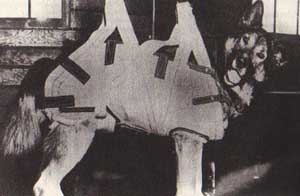
US Parachute Sled Dog with Rimini Harness - from National Archives - World War II
The Pack Dog Branch restocked with northern dogs, bred and trained soley for packing. No definite breed was considered best, but a mixture of Malamute, Mackenzie River husky, wolf and some Alsatian had the most of the desired qualities. Dogs were selected by the following criteria: weight 110-135 lbs; broad heavy chests, heavy, padded shoulders, no swayback, and heavy hindquarters with straight legs. Dogs used for military packing were the same ones that natives in Alaska, Yukon & British Columbia used for packing and heavy freighting.
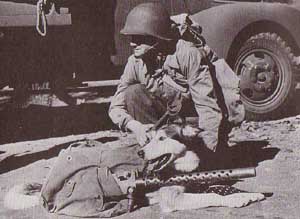
Army Pack Dog
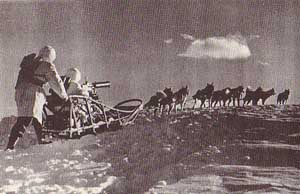
US Army publicity photo of Sled Dogs in World War II
guns were never used on sleds except for this photo

Sled Dogs on their way to France with soldiers
They served from Alaska to France, but were especially valuable in Greenland, where they rescued many downed flight crews. The faster Siberian Huskies were preferred for sled teams, but Malamutes served on them, too, as not all missions called for speed, but for strength. Malamutes also worked as pack dogs in areas unsuitable for sled operations.
Many dogs gave their lives during this war, including Alaskan Malamutes. The losses to WWII added to the loss of the dogs destroyed in Antarctica brought the number of breeding dogs dangerously low.
Many of these war veterans went on to serve as part of the Distant Early Warning line stations.
adapted from Soldiers & Sled Dogs by Charles L. Dean
1950 AKC reopened stud book
The base stock of Malamutes dropped to 30 registered dogs (many lost to Antarctic Expeditions and WWII), and the AKC reopened the stud books. The AMCA, headed by Seeley, was resentful of this as they did not consider other Malamutes "representative of the breed". However, M'Loot and Hinman-Irwin owners were very happy. To be registered the dogs had to be shown and gain points, with multiple view photos accompanying their registration application. After 1950, the Alaskan Malamute became is mixture of Kotzebue, M'Loot and to a lesser extent Hinman-Irwin, which strengthened and improved the breed.
Seeley and others were upset over the inclusion of the M'Loots which many considered another breed, but for the AMCA to become an AKC member club, they opened membership of the AMCA to M'Loot owners.
Robert Zoller - Husky-Pak Kennels
Zoller served as a naval officer in Newfoundland during WWII and was impressed with "appearance of fierceness and power, yet gentle disposition" of Alaskan Malamutes. He went to Chinook Kennels to look at Malamutes, but found them too small. Chinook Kennels sent to see Dick Hinman and Zoller loved the look of what he saw (Hinman-Irwin dogs). He felt they compared favorably to both Seeley's and Voelker's dogs. He and his wife bought Hinman-Irwin, and M'Loot dogs. Zoller creditted the Hinman-Irwin dogs with giving some balance to the M'Loots and making a better overall dog. He still admired the Kotzebue look and did incorporate them in his breeding program. The success of his crosses influenced other M'Loot breeders, who incorporated Zoller's Husky-Pak dogs into their breeding programs. Some incorporated Kotzebue's into their breeding programs, while some M'Loot breeders stayed with their own strain, as did many Kotzebue kennels stay with their own.
Zoller's Husky-Pak Alaskan Malamutes won an impressive amount of championships over an about 12 year period with just 12 litters.
A very frank look at the early AMCA days and the ridiculous political infighting and dirty tricks that went on with Seeley's camp trying to discredit any Malamutes (M'Loots and & Zoller's Husky-Pak) but her own as not purebred (especially as M'Loots and Husky-Paks began winning championship after championship) is here in an interview with an 83 year old Robert Zoller
"Despite what our standard says, I am not at all convinced that 85-lb males and 75-lb females are "the ideal freighting size". That statement was a compromise, the best we could do then, and a lot better than the way it was. But, I always felt the "original Malamute was a big dog, even after many generations of survival in a harsh environment. I think the old photos show that. In the 1950s, near Lake Placid, NY, I saw real, honest-to-God good-type Malamutes, brought out of the arctic by Jacques Suzanne, that were bigger than any real Malamutes I have seen before or since.
For many reasons I was told that anyone who ever worked sled dogs had found that big dogs "much less efficient" thant the smaller ones. Some even said any dog over 80-lbs was clumsy and more likely to break down and drop out. Not being a driver, I couldn't argue. But now that opinion has been made to look silly by Will Steger and his gallant companions who journeyed totally across Antarctica in what has to be said the greatest feat of human and canine endurance ever on this earth. They accomplished with teams of 100-lb dogs - and their performance was magnificent!"
Robert Zoller
Hollywood with Malamutes
Yukon King - TV show from the 50s / 60s featuring
Sgt Preston and Yukon King,
a giant Malamute (real name Kim of the North
from Ro-Ala-Ken Kennel).
The Christmas Tree - 1969 movie
also known as When Wolves Cry
featured dogs from Ro-Ala-Ken
Back to God's Country
Call of the Wild
The Wild Country
The Wild North
Strategic Air Command
Lost in Alaska
Mrs. Mike
|
The Ice Palace
The Man from Shilo
Wolf Track
Savage Same
The Alaskans - TV show
Niki Dog of the North
The Journey of Natty Gann
White Fang
Iron Will
|

Information & Official Links
The Alaskan Malamute Club of America
Link opens new browser window to this article from
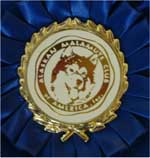
Alaskan Malamute FAQ
Link opens new browser window to this copyrighted article
Alaskan Malamute Breed Standard - AKC
Link opens new browser window to this copyrighted standard
So You Want an Alaskan Malamute?
Link opens new browser window to this article by M.Serage on the Alaskan Malamute Assistance League site
A Brief History of the Alaskan Malamute
Link opens new browser window to this article by Lynda Birmantas on the Alaskan Malamute Assistance League site

|




